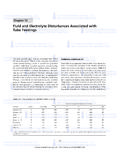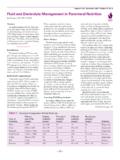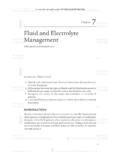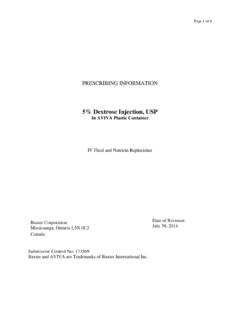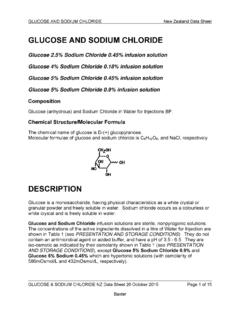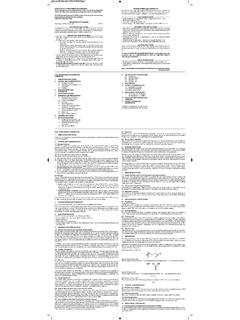Transcription of PICOSALAX - Medsafe
1 -1- PICOSALAX . Sodium picosulfate , magnesium oxide , citric acid Presentation White crystalline powder. Active ingredients: sodium picosulfate with magnesium citrate formed in solution from magnesium oxide and citric acid Sachets containing of powder for oral solution. Inactive: potassium bicarbonate (equivalent to 5mmol [195mg] potassium), saccharin sodium, orange flavour (containing lactose). Uses Actions The active components of PICOSALAX are sodium picosulfate, which stimulates bowel movements following metabolism by colonic bacteria, and magnesium citrate which acts as an osmotic laxative by increasing intestinal osmotic pressure thereby promoting retention of fluid within the bowel. The combined action of these components results in evacuation of the bowel contents. Pharmacokinetics Sodium picosulfate itself is pharmacologically inactive but is metabolised to an active metabolite, desacetylbisacodyl (bis(p-hydroxyphenyl)pyridyl-2-methane), which influences the chemoreceptors in the mucosa to increase intestinal motility.
2 Desacetylbisacodyl is the same active metabolite formed following ingestion of bisacodyl, is insoluble in water and is minimally absorbed from the gastro-intestinal tract. Indications For clearance of the bowel prior to examination by radiography, endoscopy or surgery. Dosage and Administration Instructions for timing of dose and dietary and fluid restrictions vary greatly between centres and may over-ride the recommendations given below. Clinical studies with PICOSALAX have shown the following regimens to be effective. Adults (including the elderly) and children aged 9 years of age and older: (if the procedure is scheduled for the afternoon, it is recommended that the Split-Dose regimen be used): Split-dose Regimen (evening-before and day of the procedure). The first PICOSALAX sachet is taken the night before the procedure, and the second is taken the next day, in the morning prior to the procedure.
3 On the day before the procedure - 1 sachet: The first reconstituted sachet is taken in the evening ( 5:00 to 9:00 pm), followed by at least five 250mL drinks of clear liquids, spread over several hours On the day of the procedure - 1 sachet: PICOSALAX - PICOSAL004 12 January2015. -2- The second reconstituted sachet is taken in the morning (5-9 hours before the procedure), followed by at least three 250mL drinks of clear liquids, spread over several hours Clear liquids may be consumed until 2 hours before the time of the procedure. or Day-Before Regimen (evening-before the procedure only). The first PICOSALAX sachet is taken in the afternoon or early evening and the second is taken approximately 6 hours later, the night before the procedure. On the day before the procedure - 2 sachets: The first reconstituted sachet is taken in the afternoon or early evening ( 4:00. to 6:00pm), followed by at least five 250mL drinks of clear liquids, spread over several hours The second reconstituted sachet is taken in the late evening ( 10:00pm to 12:00am), followed by at least three 250mL drinks of clear liquids, spread over several hours Clear liquids may be consumed until 2 hours before the time of the procedure.
4 Directions for Reconstitution Immediately before use, mix the contents of one sachet in approximately 150mL ( of a cup) of water. Stir for 2-3 minutes, the solution should now become an off-white, cloudy liquid with a faint odour of orange. If it becomes warm wait until it cools sufficiently to drink. Drink the solution. Do not prepare the solution in advance. Further Information Patients should be warned to expect frequent, loose bowel movements. To avoid dehydration it is recommended to drink a sufficient amount of clear liquids whilst the effects of PICOSALAX persist. Apart from the liquid intake together with the treatment regimen ( PICOSALAX + additional liquids), a normal, thirst driven intake of clear liquids is recommended. Clear liquids may include water, clear soup, fruit juice without pulp, soft drinks, tea and/or coffee without milk (including soy and cream).
5 Patients should be advised NOT to drink just water alone but to also drink a balanced electrolyte solution;. drinking only water to replace fluid losses may lead to electrolyte imbalance, particularly hypokalaemia or hyponatraemia and possibly seizures (see Warnings and Precautions). Patients should be instructed to consume only clear fluids (no solid food or milk) on the day before the procedure up until 2 hours before the time of the procedure. Contraindications PICOSALAX is contraindicated in patients with congestive heart failure, known or suspected gastrointestinal obstruction or perforation, gastric retention, gastro-intestinal ulceration, toxic colitis, toxic megacolon, ileus, those with a stoma, nausea and vomiting, acute surgical abdominal conditions such as acute appendicitis, severe dehydration, rhabdomyolysis, hypermagnesemia, active inflammatory bowel disease or hypersensitivity to any of the ingredients.
6 In patients with severely reduced renal function, accumulation of magnesium in plasma may occur. Another preparation should be used in such cases. PICOSALAX - PICOSAL004 12 January2015. -3- PICOSALAX should not be used in patients with undiagnosed abdominal symptoms. PICOSALAX should not be used in children under 9 years of age. Warnings and Precautions Life-threatening dehydration and/or electrolyte disturbances may occur in at risk'. groups (see Contraindications'). Use with caution in patients with recent gastro-intestinal surgery, renal impairment, heart disease or inflammatory bowel disease. Those patients with kidney disease, or impaired renal function should be monitored, as should those with pre-existing electrolyte disturbances. Diabetics may need adjustment of their medication and careful monitoring of their blood glucose. Patients using diuretics or other medications (such as corticosteroids, lithium) that may affect water and/or electrolyte balance should also be monitored (See Interactions).
7 In all patients, adequate fluid intake should be maintained. An insufficient or excessive oral intake of water and electrolytes could create clinically significant deficiencies, particularly in less fit patients. In this regard, children, the elderly, debilitated individuals and patients at risk of hypokalaemia may need particular attention. Prompt corrective action should be taken to restore fluid/electrolyte balance in patients with signs or symptoms of hypokalaemia or hyponatraemia. Drinking only water to replace the fluid losses may lead to electrolyte imbalance. The period of bowel cleansing should not exceed 24 hours because longer preparation may increase the risk of water and electrolyte imbalance (See Dosage and Administration). PICOSALAX may modify the absorption of regularly prescribed oral medication and should be used with caution there have been isolated reports of seizures in patients on anti-epileptics, with previously controlled epilepsy (see Interactions and Adverse Effects).
8 This medicine contains 5mmol (or 195mg) potassium per sachet. This should be taken into consideration by patients with reduced kidney function or patients on a controlled potassium diet. PICOSALAX contains lactose as a component of the flavour (approximately 5mg per sachet). Patients with rare hereditary problems of galactose intolerance, the Lapp lactase deficiency or glucose-galactose malabsorption should not take this medicine. PICOSALAX is not intended for use as a routine laxative. Use in children PICOSALAX should not be used in children under 9 years of age. Use in pregnancy and lactation Whilst animal reproduction studies with sodium picosulfate have revealed no evidence of a harmful action on the foetus, clinical experience of the use of PICOSALAX during pregnancy is limited and caution should be observed, particularly during the first trimester. PICOSALAX - PICOSAL004 12 January2015.
9 -4- Use in lactation Neither sodium picosulfate nor magnesium citrate has been shown to be excreted in breast milk. As there is no experience with the use of PICOSALAX in nursing mothers, the product should only be used if clearly indicated. Adverse Effects The most frequent adverse reactions seen in clinical trials are nausea, headache and vomiting. MedDRA Common Uncommon Not known Organ Class ( 1/100 to 1/10) ( 1/1000 to <1/100) (cannot be estimated from the available data). Immune system Anaphylactic reaction, disorders hypersensitivity Metabolism and Hyponatraemia and nutrition disorders hypokalaemia Nervous system Headache Epilepsy, grand mal disorders convulsion, convulsions, confusional state Gastrointestinal Nausea and Vomiting, abdominal Diarrhoea, faecal disorders proctalgia pain, aphthoid ileal incontinence ulcers*. Skin and Rash (including subcutaneous tissue erythematous and disorders maculo-papular rash, urticaria, purpura).
10 * Isolated cases of mild reversible aphthoid ileal ulcers have been reported The frequencies of the adverse effects are based on post-marketing experience. Diarrhoea and faecal incontinence are the primary clinical effect of PICOSALAX . Isolated cases of severe diarrhoea have been reported post-marketing. Hyponatraemia has been reported with or without associated convulsions (see Warnings and Precautions). In epileptic patients, there have been isolated reports of seizure/grand mal convulsion without associated hyponotraemia. There have been isolated reports of anaphylactic reaction. Interactions As a purgative, PICOSALAX increases gastrointestinal transit rate. The absorption of other orally administered medicines ( anti-epileptics, contraceptives, anti-diabetics, antibiotics) may therefore be modified during the treatment period (see Warnings and Precautions). Broad spectrum antibiotics may decrease the effect of PICOSALAX by interfering with the colonic bacteria needed to break down sodium picosulfate to form its active substance.










